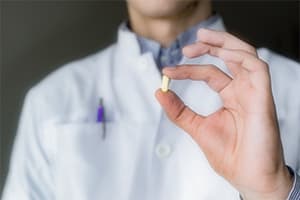
Naltrexone Treatment for Heroin and Opiate Addiction

Naltrexone is a relapse-prevention drug commonly used in the treatment of opioid and alcohol addiction. By blocking the desired effects of these substances, naltrexone helps reduce cravings and relapse episodes over the long term. Unlike other treatment medications, like methadone or buprenorphine, naltrexone has no potential for abuse or addiction.1
What Is Naltrexone?
Naltrexone is an opioid antagonist available in a number of formulations, including Vivitrol.1 It is available as a pill that is taken orally every 1–3 days, or as a longer-lasting injection or implant.1,2
As an opioid antagonist, naltrexone inhibits the euphoric high of heroin and other opioid drugs by preventing them from binding to and activating opioid receptors in the brain. This is different from opioid agonists, which function by activating the brain’s opioid receptors to produce their pleasurable effects. Opioid agonists include heroin and prescription painkillers like morphine and oxycodone, as well as drugs commonly used in addiction treatment such as methadone and buprenorphine.1,3
Naltrexone is prescribed to reduce cravings and prevent relapse during addiction treatment by making the patient physically unable to feel the desired effects of opioids. The FDA has also approved naltrexone for the treatment of alcoholism.

Naloxone vs. Naltrexone
Naltrexone can be confused with naloxone, as they’re both opioid antagonists with similar names and medical uses. While both drugs block the effects of opioids on the brain, Naloxone is a shorter-acting antagonist, making it more appropriate for the rapid treatment of overdose emergencies. Naltrexone is longer-acting and is more effective as a maintenance drug for discouraging continued opioid or alcohol abuse and preventing relapse.1,3,4
Naltrexone for Heroin Addiction Treatment
Naltrexone may be used during heroin addiction treatment, or for months or even years afterward as a maintenance drug to prevent relapse.
Medication-assisted treatment: During rehab, naltrexone may be administered as part of a medication-assisted treatment program once the patient has successfully completed detox. It is important that the patient have no opioids in their system when beginning naltrexone therapy, otherwise they could experience sudden and severe withdrawal symptoms.1
Addiction professionals recommend that patients abstain from all opioid medications—including methadone and buprenorphine, which may be administered during heroin detox to ease withdrawal symptoms—for a minimum of 7–10 days before beginning a naltrexone regimen.5 Naltrexone is most commonly administered in an outpatient rehabilitation setting.3
Long-term maintenance and relapse prevention: In addition to use in early heroin addiction treatment, naltrexone can also serve as a long-term maintenance treatment by helping to prevent relapse. It is usually administered orally, with dosage ranging from daily to several times per week. Alternatively, a longer-acting naltrexone injection may be given once a month.1
The drug is not an agonist and does not provide any reward to the user.
Continued absence of the pleasurable effects of opioids, coupled with the patient’s knowledge that using heroin or other opioid drugs would be futile, gradually reduces cravings over time.2 This is not the case with all patients, however, and because the drug is not an agonist and does not provide any reward to the user, compliance with treatment can be poor.3
Naltrexone is most effective for those who are highly motivated to stop using opiates. Compliance may be greater with the extended-release naltrexone, as the drug stays in the system longer and only needs to be re-administered once a month.3
Naltrexone is not a stand-alone treatment option for heroin or other opioid addictions. Rather, it should be used in combination with other addiction therapies, such as individual and group therapy, support groups, and 12-step programs.
Naltrexone for Alcohol Abuse Treatment

In addition to opioid addiction, naltrexone is also used to treat alcohol dependence.5,6 Naltrexone blocks some of the rewarding feelings of intoxication caused by alcohol, giving those who have difficulty remaining abstinent on their own the motivation to reduce their drinking behaviors and stay in treatment.5 Studies have shown that naltrexone reduces relapses in alcoholics trying to remain sober, and also reduces the quantity and frequency of alcohol consumption in those who do drink.6
Naltrexone is not addictive and does not have any adverse reactions with alcohol.6 Most studies have found naltrexone to be most effective at treating alcohol when used for at least 3 months, and some researchers recommend using the drug for at least 6 months.5,6
Just as in opioid addiction therapy, naltrexone alone is not enough to fully and successfully treat alcohol addiction. A combination of naltrexone with counseling and behavioral therapy is recommended to prevent relapse and sustain recovery.
The effective dose of naltrexone for alcohol abuse treatment can vary depending on individual physiology, abuse history, and other factors. Naltrexone injections may be given in lieu of oral medications, however; injections should not be used in patients who are still actively drinking alcohol.7 It should also be noted that naltrexone will not prevent withdrawal symptoms from occurring when the patient stops drinking.7
Naltrexone Implant
People addicted to heroin and other opioids can be ambivalent about their use and have a high incidence of relapse.
Clinical trials have found the naltrexone implant to be 3 times more effective at preventing heroin relapse than a daily oral naltrexone dosage. The implant provides a steady dose of the drug for 2 months at a time. The implant is placed in the skin through a small incision and is biodegradable, so it does not require removal. This method of delivery is an ideal alternative to more frequent oral dosing for patients who may falter in their commitment to sobriety.
One of the biggest downfalls of naltrexone treatment is patient compliance, particularly because the drug does not reliably eliminate cravings.2 People addicted to heroin and other opioids can be ambivalent about their use and have a high incidence of relapse—one week they’re highly motivated to abstain from drugs, but the next week they could give in to the cravings.7 Patients on oral naltrexone could decide to stop taking their medication in favor of getting high again, but patients with a long-lasting naltrexone implant don’t have this option available.2
Even with the long-lasting effects available via naltrexone implants and injections, complete addiction therapy is necessary to maintain lasting recovery.
Naltrexone Side Effects
Like any drug, there are side effects that may occur when taking naltrexone, whether in the oral pill form or extended-release injections or implants. Some side effects that may occur when taking naltrexone include:8,9

- Headache.
- Nausea.
- Vomiting.
- Dizziness.
- Abdominal cramps.
- Tearfulness.
- Restlessness.
- Sleepiness.
- Decreased appetite.
- Bone pain.
- Joint pain.
- Muscle cramps.
- Difficulty sleeping.
- Toothache.
- Cold-like symptoms.
- Depressed mood.
Other signs and symptoms to be aware of that may be indicative of an allergic reaction include:8,9
- Difficulty breathing.
- Swelling of the face, mouth, tongue, or eyes.
- Chest pain.
- Skin rash.
- Feeling faint.
- Pneumonia (rare).
Some side effects that are unique to naltrexone implants and injections include: 2,7
- Infection and irritation at implant insertion site.
- Pain, swelling, itching, blisters, lumps, hardness, and/or open wounds at injection site.
In addition to the above side effects, there are also several precautions patients should be aware of before taking naltrexone.
Symptoms of withdrawal could appear as soon as 5 minutes after an oral dose of naltrexone.
Sudden withdrawal: It is important for naltrexone patients to detox from all opiates for at least 7–10 days before their first dose of naltrexone, otherwise the body could go into sudden and severe withdrawal.1,5 Symptoms of withdrawal could appear as soon as 5 minutes after an oral dose of naltrexone.8 Some patients even carry a card that discloses their treatment information in case of emergency to ensure that they are not given any opioid medications in these situations.1
Vulnerability to overdose: Naltrexone treatment can increase the risk of opioid overdose in 2 ways. First, because naltrexone works by blocking opioid receptors and preventing the patient from feeling high, some people take large amounts of heroin or other opioids in an attempt to override the effects of the naltrexone.1 This is very dangerous and can lead to death.
Second, people can also experience overdose brought on by a decreased tolerance to heroin or opioids. After naltrexone treatment, patients who return to drug use may not realize that their tolerance has decreased and take their usual dose prior to detoxification, thus inducing an overdose.7
Risk of hepatitis or other liver damage: Naltrexone may cause serious liver inflammation (hepatitis), damage, and dysfunction.7–9 Patients should be screened for liver problems before beginning naltrexone treatment. Those with pre-existing liver conditions may not be good candidates for the use of naltrexone. If you experience any of the following symptoms of liver dysfunction, report them to your physician immediately:
- Yellowing of the whites of the eyes
- Yellow skin
- Light-colored bowel movements
- Dark urine
- Stomach pain lasting more than a few days
- Excessive tiredness

Depression and suicidal thoughts: Though depression and thoughts of suicide have been reported with naltrexone treatment, it has generally been concluded that these symptoms are not directly caused by the medication itself, but rather are associated with the long-term opioid or alcohol dependence for which naltrexone is prescribed.1,8 With this in mind, it is important to note that naltrexone does not manage or ease symptoms of depression in any way. Patients should make their caregiver, close friends, and family members aware of their naltrexone use and any personal history of depression or suicide so that they can provide successful intervention if necessary. Any new or worsening symptoms of depression should be reported to a doctor or mental health professional as soon as possible.
Is Naltrexone Addictive?
Substance abuse treatment experts agree that naltrexone poses minimal risk for abuse or addiction, and it can be stopped suddenly with no withdrawal symptoms or other adverse effects.1 Even though it does not produce a high or create physical dependence, naltrexone should still be taken only as prescribed by a doctor. Your physician can monitor your recovery progress and address any adverse side effects, as well as make sure that your dosage is appropriate and all necessary safety precautions are in place.1
Seeking Help for Heroin or Opioid Addiction
Opioid addiction is a chronic disease with high potential for relapse. While there is no single approach that will work for everyone, medications such as naltrexone can help reduce cravings and prevent relapse when used as part of a comprehensive treatment regimen that includes individual therapy, group counseling, 12-step programs, and a relapse-prevention aftercare plan.
Helpful Resources For Heroin Treatment
Sources
- Substance Abuse and Mental Health Services Administration. (2014). The Facts about Naltrexone.
- National Institute on Drug Abuse. (2013). Naltrexone Implant Outperforms Daily Pill in Russian Trial.
- National Institute on Drug Abuse. (2012). Opioid Addiction.
- National Institute on Drug Abuse. (2016). Opioid Overdose Reversal.
- Substance Abuse and Mental Health Services Administration. (2016). Naltrexone.
- Leavitt, S. (2002). Addiction Treatment Forum Naltrexone Clinical Update: Evidence for the Efficacy of Naltrexone in the Treatment of Alcohol Dependence (Alcoholism).
- U.S. National Library of Medicine. (2010). Naltrexone Injection.
- Food and Drug Administration. (2013). Revia.
- Food and Drug Administration. (2013). Vivitrol.
Heroin Rehabilitation Directory
Select a state to learn more about your treatment options.- Alabama
- Alaska
- Arizona
- Arkansas
- California
- Colorado
- Connecticut
- Delaware
- District Of Columbia
- Florida
- Georgia
- Hawaii
- Idaho
- Illinois
- Indiana
- Iowa
- Kansas
- Kentucky
- Louisiana
- Maine
- Maryland
- Massachusetts
- Michigan
- Minnesota
- Mississippi
- Missouri
- Montana
- Nebraska
- Nevada
- New Hampshire
- New Jersey
- New Mexico
- New York
- North Carolina
- North Dakota
- Ohio
- Oklahoma
- Oregon
- Pennsylvania
- Rhode Island
- South Carolina
- South Dakota
- Tennessee
- Texas
- Utah
- Vermont
- Virginia
- Washington
- West Virginia
- Wisconsin
- Wyoming
Help for Heroin Addiction
Do you know someone suffering from heroin addiction? Help is available. To find out more, please choose the selection that applies to you or the person suffering from addiction:
Fill out the form below to be contacted.
Repair the damage and start fresh today!

